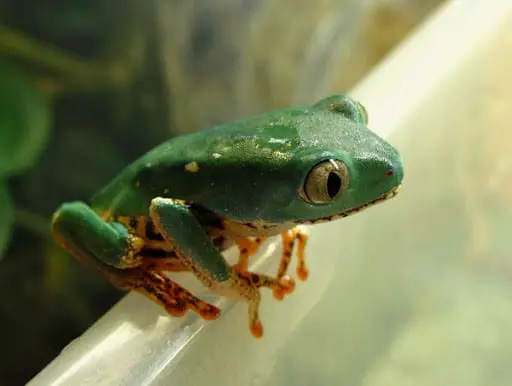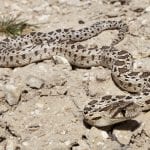Scientific Facts
| Common Name: | TIGER-LEG MONKEY FROG |
| Scientific Name: | Phyllomedusa tomopterna |
| Life Span: | 10 years in captivity |
| Size: | 1.5 to 2.0 inches (males), 2.4 inches (females) |
| Habitat: | Pristine tropical rainforest |
| Country of Origin: | Northern South America |
Overview
The tiger-leg monkey frog is native to the Amazon rainforest. They are attractive and interesting species of amphibians to raise in captivity, giving enough care. They are nocturnal. They sleep all day and wake up at night to look for food, soak in water, and vocalize for males. They are very similar to the red-eyed tree frog.
Phyllomedusa, the genus name, has 30 species which are found in South America. Their common name monkey frog is connected to the opposable first digit used for gripping branches as well as plants. They don’t hop. They walk and slowly creep at night on vegetation looking for prey. They are named in numerous ways like super tiger leg monkey frog, barred leaf frog, and tiger-striped monkey frog.
Description
On the back of this frog is solid green. their eyes are strikingly silver. They have a yellow tiger and black stripes on their legs. When they are threatened, they just display their bright legs to intimidate their predator.
These species belong to the waxy monkey tree frogs. They are named for having a gland on their elbow’s back that secretes wax. The wax is rubbed all throughout their bodies. They keep moist, which is useful during dry times. The term monkey frog is coined because of their habit of walking like a monkey instead of jumping.
They appear turquoise in some conditions, but generally, they have a darker forest green. When sleeping during the day, their bright stripes are hidden. They only show the beautiful black bands and tangerine color at night.
Range and Habitat
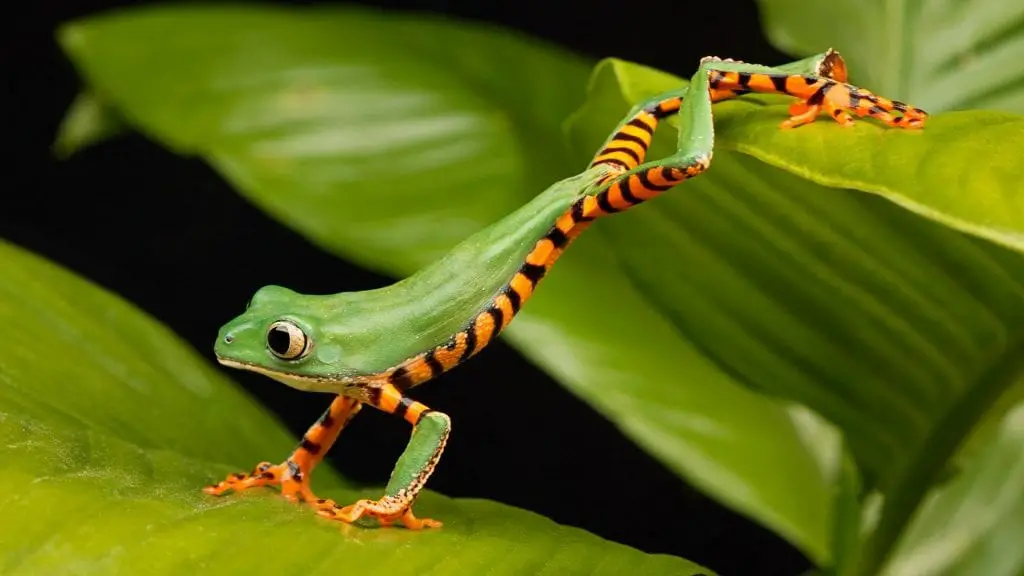
They are found in tropical forests. They are largely distributed in the amazon basin until Suriname, French Guiana, and Guyana. They are seen mostly in trees and pools during the rainy season where they breed. Here, they are heard sometimes calling from leaves overhanging after the raining, particularly from November to May.
Size
The male can grow from 1.5 to 2.0 inches, whereas females grow up nearly 2.4 inches’.
The lifespan of Tiger Leg Monkey Frog
Phyllomedusa tomopterna or tiger leg monkey frog can live for more than ten years in captivity. Of course, it would be under ideal conditions. The average lifespan of this frog is 4 to 5 years.
The Life Cycle of a Frog
Amphibians can live on land or in water. They undergo some stage before they turn adult.
Stage 1: Egg
All frogs start as a fertilized egg. Their mother frog lays them at one time in a pond or body of water. For tiger leg monkey frog. Eggs are laid on a leaf. These eggs float on the water, having jelly mass. Later, they will hatch into tadpoles.
Stage 2: Tadpole
When the eggs are hatched, they resemble a fish. They don’t have legs. They have gills for breathing underwater. They swim, eat algae and plants in the water. They will grow after some weeks. At this stage, their lungs start to develop, and they can now breathe outside the water. Then, their hind legs begin to grow. They can now leap. They have long tails. By this time, they now look like a frog and not a fish anymore.
Stage 3: Young Frog
Their 2 front legs start to grow, and the tail gets shorter. They use the nutrients from their tail as a food until it is gone permanently. It hops out of the water and dry land. Still, they are small.
Stage 4: Adult Frog
The tail is gone forever. They will eat insects and not plants. It will take 2 to 4 years until they turn to adults. Then, they will lay eggs, become tadpoles, and the cycle starts again.
Behavior
They are nocturnal. They love spending their time in the trees or tall shrubs. In the Amazon rainforest, breeding happens in the wettest time of the year. That is from November to May. The males call from the plants and trees after they are spurred by strong rain.
Tiger legs lay eggs on a leaf found above the water. Then, they wrap it in a nest and sealed by jelly as protection. They can lay over 100 eggs at 2 or 3 leaves. Tadpoles wriggle to free themselves from the jelly. Then, they fall into the pool found below.
Food
For the long term health of your frog, providing a variety of diet of live insects is vital. Crickets, fruit flies, and other live reptiles are the best. Give your adults once every 5 days or more of 2 to 8 items for every frog. The juveniles can eat every night. That would be wax worms and roaches. Feed them at night since they are active and ready to eat.
Give them supplements rich in minerals and vitamins to avoid deficiencies and imbalances too. When giving them the supplements, coat the food with powder. Do it every time you feed the juveniles, while it would be every other feeding for the adults. the supplement should have vitamin D3, vitamin A, calcium and should not have phosphorus. Replace the supplement you give every three to six months.
Sexing Monkey Frogs
The males in these species are smaller compared to the females. Males grow from 1.7 to 2.1 inches. The females are 2.4 inches and appear broader in terms of the structure of their bodies. Males vocalize, but girls are quiet. When breeding, begins with the group of a biased large male. Using 6 or more males and 3-4 females are ideal.
Breeding
In order to breed these frogs, their environment should be manipulated. The females must be fed well in order for them to produce eggs. If their environment is not right, then breeding will not take place. Breed only those that are healthy. Note that newly obtained individuals may suffer stress and lead to health problems.
Follow a period by keeping the humidity and temperature constant or dry and a little cool. Do it by misting the terrarium using water a few times a day. Restrict the ventilation by taping a piece of plastic wrap or glass over the enclosure’s cover. Heavy misting boosts the level of humidity. You should be able to replicate heavy rains. If it works, the males start to call every night when the lights are off.
Apart from increasing the humidity, start to feed them every night as well. Give a variety of foods such as roaches, flies, and crickets. Remove leftovers from their cage. Feed them as much at night. Mist and feed until they get the right weight and the males frequently vocalize.
Enclosure
A 20-gallon aquarium is big enough for six to eight adults, while juveniles can be in a smaller size of 5 to 10 gallons. Plastic storage containers can be used for housing. Make a large hole in the plastic box’s cover and use a fiberglass window for them not to escape. Glass that is arboreal style glass is ideal for housing.
For the substrate, sphagnum moss is the best. Keep it clean and moist. You can use it for a longer time. It doesn’t need frequent changing. If smell stinks, that’s the time you need to change it. Earthy and fresh smell means a healthy space for the frog. Sphagnum is light tan while moss is green.
Pat moist sphagnum moss down tightly to form a substrate that is a natural sponge. This is to prevent frogs from ingesting pieces accidentally or causing irritation to their skin. For its natural appearance, scatter some leaves over the moss. On some days, your frogs will sleep on these dry leaves.
Paper towels can be a substitute if you are not into a natural look for your terrarium. Just make sure your towels are moist and have to replace a few times a week. If you choose a terrarium with drain, then there might be a need for substrate, just flush the waste a few times a week, and there would be a lot of space above the ground for them to sleep.
Across the substrate’s bottom, put some driftwood branches for the frogs to perch in the night and a dish of water for their soaking. 1 to 2 inches in depth is enough. Don’t use water with chlorine. Use tap water that has chemicals to remove chloramines and chlorine. Wait for a day before putting it in the dish. You can buy the chemicals at pet stores. Bottled water can be used too. Replace the water in the dish every day as they soak in it regularly and defecate too.
Lighting and Heating
A photoperiod of ten to twelve hours a day. It is helpful to plug the lighting into a timer that’s automatic; thus, the lights can go on and off every day. Use low strength UVB lighting, put it over a screen section of the enclosure above the area where your frog sleeps at day time. the temperature should range from 75 to 82F. the incandescent light bulb of low wattage can be utilized to heat the terrarium fi necessary.
At the temperature can decrease by five to ten degrees. Again, mist your terrarium using a reptile mister once a day to the moist in the substrate and the level of humidity too. You use a device to measure the temperature and humidity.
Rain Chamber in the Terrarium
Move the group to the main chamber when males are calling, and the females seem to be full of eggs. The heavy rains and changes in the pressure in the atmosphere stimulates breeding.
Here’s how you can create a rain chamber:
- Fill a large and vertical enclosure with water having 2-3 inches, then put the pump at the bottom. The pump rate can be 100 gallons an hour. Lesser or more is okay.
- Then attach a flexible tube to the pump then let it run on top of the enclosure.
- Crisscross it several times. You can use fishing line or plastic wire ties for security. then, with small holes puncture the tube.
- Use filter foam to plug the end or use a wire tie to tie it. To make it rain, turn the pump on. To form a drop like water, adjust the whole amount in your tube.
Put an aquarium heater that is submersible and has a thermostat for adjusting the temperature. Try to experiment with various temperature to check if it helps in production stimulation. Set the heater to 70 to 80 degrees.
Another crucial thing is using the right plants having the right leaves. Golden pothos and Philodendron can be used and grown using gravel and will be put in the water at the bottom of your rain chamber. Drape these plants over the tube that supplies water. Secure them that there will be a lot of leaves hanging above, so there will be a place for eggs to be deposited. At night, check for amplexus and eggs every day.
The eggs will be covered with eggs and will not look obvious. When breeding doesn’t happen in a week or 2, put them back in the normal terrarium. Then continue feeding them heavily. Return them to the chamber after adjusting the temperature of the water as well as the frequency of the pump to produce the rain. Plug your pump into a timer to set. Be patient, and try repeatedly.
Husbandry
When the eggs are laid, you can take the leaf nest to another aquarium and let it suspend few inches above the water or just take the frog from the chamber so it will not cause disturbance and just wait for them to be hatched. When the eggs are hatched, just scoop them out of the water. Then move them to the aquarium.
Normally, around seventy eggs are in a clutch. That is when they are in the wild, but in captivity, it will take ten to fifteen gallons to keep this number. Filter the water using a sponge if the tadpoles start to feed actively. Feeding them can be possible after a few days to a week. Feed them with tropical fish offering as much as they can. Heat the water up to 75- 80 degrees and change the water by 25 to 50 percent once a week.
Froglet Care
When you notice the front arms, move them to a small container filled with a half-inch of water. Don’t let them drown with too much water. Put some dead leaves to make sure they are safely developed until the tail is absorbed completely.
Once their tail is gone, transfer them to a 5 to 10-gallon aquarium with having a moist paper towel as a substrate plus some artificial plants and water dish. Feed them with small crickets or fruit flies each night. Put supplements with vitamins and minerals. Give UVB lighting and the same range of temperature as that of adults. juveniles grow fast when they eat every day. They can reach adult size in a year or less.
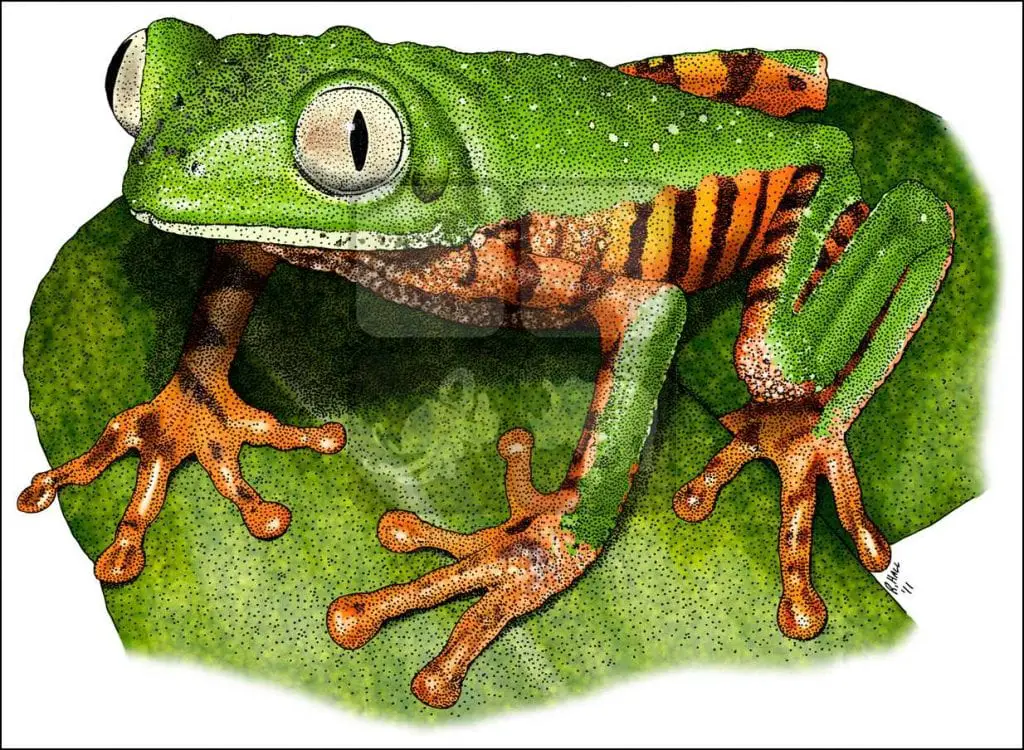
Handling
These frogs are not good to handle. They are best kept for display, making the terrarium attractive. In case you must handle them, wet your hand slightly so you will avoid harming them, or you wear disposable and powder-free gloves. Most importantly, your hands should be clean.
Choosing A Tiger-Leg Monkey Frog
Tiger-leg monkey frogs tend to be fragile. Start by choosing a healthy one for a successful raising. The wild-caught ones from Suriname are avoided due to the difficulty of adapting to captivity. They may look healthy when buying but can get sick as caused by parasites inside. This may be a result of transport. If you want to take the risk of breeding, ask the assistance of a vet.
Luckily, the captive-bred are now sold and give keepers a safer way to begin on their own. You can get your own captive bred frog from a trusted frog breeder on the internet or at herp expos. Buy juveniles that are one inch or more. check their condition before you take them home. Healthy ones sleep at day time. If you aim to breed, purchase a larger group having 8 or more.
Don’t handle them unless you need to do so. Remember to wear latex gloves always every time you handle them. Why? Because the oil or residue found in your hand can harm them. One thing more, since frogs secrete toxins, don’t hold your eyes, mouth, or touch your wounds after or during the handling.
Interesting Facts
- They grow up to six centimeters long. Females are a little bigger than the males.
- They are nocturnal. They hide in the plants at day time and go out at night to eat.
- Their legs are very long, and on their toes, there are sticky pads. This is a tool for them to climb and move from each branch.
- They don’t hop. They move carefully and slowly.
- They lay eggs on the leaves. When it hatches, it falls into the water.
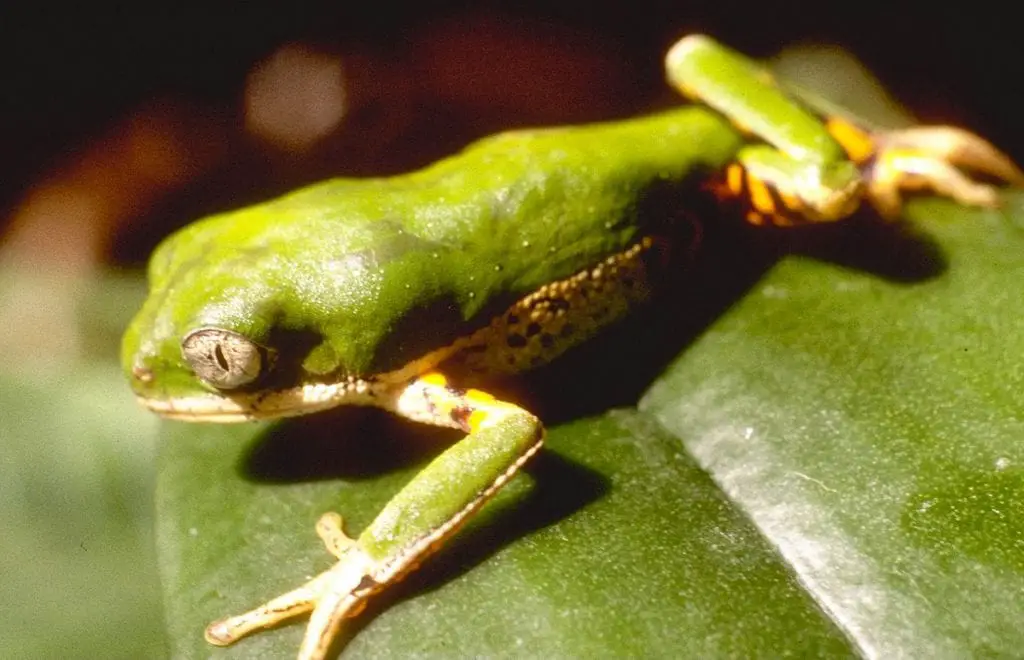
Health
Here are some signs that your frog is healthy
- Healthy skin
- Clear eyes
- Active, vocal, and sociable after dark
- Eats regularly
- Maintains weight
Health Issues
Here are the signs of red flags:
- Skin lesions
- Weight loss
- Weak leg movements
- Distressed breathing
- Lethargy
- Loss of appetite
Chemical Intoxication
Causes or symptoms: exposure to pesticides, soaps or detergents
Action: Consult your veterinarian and protect your frog from getting exposed.
Intestinal obstruction
Causes or symptoms: swallowing gravel or eating insects that are hard-shelled.
Action: Consult your vet. He or she may require surgery.
Nutritional Deficiencies
Causes or symptoms: darker or lighter skin color, lethargy, weak hind legs.
Action: See your vet for ensuring a variety of diet, give mineral supplements and vitamins.
Skin problems
Causes or symptoms: fungal and bacterial infections, abrasions
Action: Go to your veterinarian
Availability: Where to Get One?
The captive-bred are now sold by a trusted frog breeder on the Internet or at some herp expos. Check them out.
How to Care?
Diet
They are insectivores. They are fed on mealworms, fruit flies, small roaches, crickets, and the like.
Feeding
Feed them two to three times a week. Put calcium powder in their food and multivitamin one time a week.
Housing
- All ages can be put together. Put some spots to hide.
- Keep your frog in a ten-gallon tank.
- Absorbent substrate is required because of humidity. Use sphagnum moss.
- They need 78 to 82 degrees F.
- Mist your terrarium as your frogs need high humidity.
- Put a water bowl of clean water. Don’t use chlorinated water.
- Use two kinds of the bulb; a heat lamp and a UVB lamp.
FAQ Section
Where do tiger frogs live?
They live in the tropical rainforests and in the swamps of tropical and subtropical. They hang out in the canopies above water.
Do frogs breed in captivity?
Some species are successful in captive breeding, while others are found difficult or didn’t breed.
How does a frog die?
They may die due to exhaustion, especially in extreme temperatures. In the winter, they stay underwater and breathe through their skin. This can cause suffocation.
Why are frogs said to have two lives?
That means the first part of their life begins in the water as eggs. Then when they turned into tadpoles and developed fully, they start living on the land.
Do Frogs feel pain when touched?
Frogs can perceive pain as they have the nervous connections to the telencephalon.
Do Frogs like to be touched?
Yes, they can, but only when necessary. When you do, do it gently. Use gloves when handling them.
Does holding/touching a tree frog cause harm?
Yes, it does it, especially if there are residues or oil on your hand. If you don’t need to handle them, then don’t do so.
Do Frogs sleep?
There aren’t so many researches about their sleep pattern to determine if they have a true sleep period.
What noise do frogs make when mating?
The sound produced comes from the air sac below the mouth. It is inflated and deflated. The air that comes from their lungs channels to the air sac. This causes resonation that makes it louder.
How can you tell if a frog is a female or male?
They have some differences on their feet and hands. Males are smaller and have textured patches found on their hands.
Can the frog change gender?
Some West African frogs can change their sex after a successful bred. They are called sequential hermaphrodites. They have gonads from each sex at different times in their lives.
Do female frogs call?
No, they don’t. they are usually silent while males do the calling during the breeding season.
Do frogs have good eyesight?
They see well at a distance; however, they have excellent vision at night. They show sensitivity to movement.

